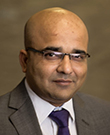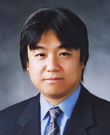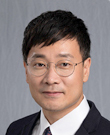Keynote & Plenary Speakers
Keynote Speakers |
Title: Multimodal Sensors in the Wild: Case Studies in Clinical and At-home Setting |

|
Dr. Shehroz Khan
Assistant Professor
Institute of Biomaterials and Biomedical Engineering
University of Toronto, Canada
Dr. Shehroz Khan is a Scientist in the Artificial Intelligence and Rehab Robotics Lab at the KITE, Toronto Rehabilitation Institute, Canada. He is also cross appointed as an Assistant Professor at the Institute of Biomaterials and Biomedical Engineering, University of Canada. He holds a PhD Degree from the University of Waterloo, Canada in Computer Science with specialization in Machine Learning. His Phd research is one of the first works to formulate fall detection as an anomaly detection problem. Prior to joining academics, Dr. Khan worked for around 10 years in India and Ireland in various scientific and research roles in government and corporate sector.
Dr. Khan’s main research focus is the development of zero-effort machine learning and deep learning algorithms within the realms of Aging, Rehabilitation and Independent Assisted Living. He currently leads the study on detecting agitation in people with dementia using multi-modal sensors. He is the project leader on an AGE-WELL funded study to validate a commercial wearable device from an industrial partner for developing spatio-temporal health indices for clinical support. He is a co-principal investigator on developing smart sensors framework to detect functional decline and social isolation in older adults post-hip surgery. He is a principal investigator on a study to assess the clinical validity of smart watches in cardiac rehab program. He is also a co-investigator on studies on developing predictive models on fall detection and sleep apnea.
Abstract
Wearable sensors provide a great opportunity to collect different modalities of health data, such as motion, heart rate, muscle movements, etc. These indicators are of great value to clinicians and caregivers to detect adverse events, monitor health conditions, or changes in behaviors. Multi-modal sensing provides a great opportunity to monitor various health indicators and build contextual profile of a person. Multi-modal sensing also leads to more robust predictive models. We will discuss two research studies that involve deploying multi-modal sensors in the wild, in a clinical and at-home setting. In the first study, we installed multi-modal sensors in a specialized dementia unit to detect episodes of agitation in people living with dementia. These sensors include a multimodal wearable device, sleep mat, ambient sensors and video cameras. We collected this unique data from 20 participants for over 600 days, and showed that multimodal wearable data significantly outperforms single sensors, and can detect agitation with 0.85 AUC. The challenges incurred in this study led to the development of an innovative system to seamlessly collect and store data on an encrypted cloud platform, to facilitate easier predictive modelling and saving time spent (human hours) on data collection. The second study is ongoing and is aimed at deploying multi-modal sensor system in an at-home setting to monitor functional decline and social isolation in older adults after discharge followed by post-hip surgery. This research further led to ethical questions around data collection, domestic surveillance, control and access people should have on their personal data. |
|
Title: From Gerontechnology Research to Daily Applications – Development and Implementation of an AIoT Bedroom for Senior Care |

|
Professor Yeh-liang Hsu
Professor
Department of Mechanical Engineering
Director
Gerontechnology Research Center
Yuan Ze University, Taiwan
Professor Yeh-Liang Hsu received his bachelor’s degree in mechanical engineering from NTU in 1985, and was conferred PhD by Stanford University in 1992. He then became a professor at Yuan Ze University, Taiwan, where he has had many important roles, including Secretary General and Dean of Academic Affairs.
Professor Hsu directed his research interest in design to the field of gerontechnology, and established the gerontechnology Research Center in 2003, which is the pioneering research institute in this field in Taiwan. He has published many papers, books and patents in gerontechnology, and is a renowned academic in this field. Professor Hsu has been actively involved in the International Society for Gerontechnology (ISG). He has chaired the 9th World Conference of Gerontechnology in 2014, and is concurrently Editor-in-Chief for “Gerontechnology” and IT Director of ISG.
In 2016, Professor Hsu founded Seda GTech Co. Ltd. Working with 8 young cofounders who were his students; Professor Hsu has been pushing gerontechnology research to real products for daily applications by the older adults and caregivers.
Abstract
Gerontechnology is only valuable if the research can be turned into real products for daily applications. After decades of development, there are many research projects and technological products aiming to help older adults and their caregivers. However, few of these technological products have been widely adopted for the care of older adults. There is a huge barrier to overcome; the fundamental problems to be solved are often design issues rather than technology issues.
Gerontechnology Research Center (GRC) of Yuan Ze University, Taiwan, was established in 2003, the pioneering research instituted in this field in Taiwan. However, it was Seda G-Tech Co. Ltd., a start-up company spin-off from GRC in 2016, that strove to sell smart care products to the homes, that completely shifted the mindset of gerontechnology development from a technologist mentality to a designer mentality. In design thinking, empathy replaces technology to become the core of the design process.
A critical goal in gerontechnology product development at GRC is to support the caregivers by providing them information on the real-time status and long term pattern of the older adult. In this regard, the Internet of things (IoT) and artificial intelligence (AI) are compelling tools. Familiar artifacts at home, such as beds, carpet, and chairs, are designed into IoT/AI products. Older adults need not change their living patterns and behaviors, or learn how to use the technologies, but live in them. In this presentation, the AIoT bedroom for senior care is used as an example to illustrate the many practical issues encountered when promoting smart care products to be used in the homes
|
|
Title: The Rise of Digital Health in Healthcare Systems: Caring for Aging Adults |
 |
Dr. Ryan Shaw
Associate Professor
Faculty Director, Duke Mobile App Gateway
School of Nursing – Health Innovation Lab
School of Medicine – Center for Applied Genomics & Precision Medicine
Duke University, The United States
Ryan J. Shaw, PhD, RN is an Associate Professor and Digital Health Scientist at the Duke University Schools of Nursing and Medicine in Durham, NC, USA. He is also the Faculty Director of the Duke Mobile App Gateway – a digital health initiative of the Duke Clinical & Translational Science Institute.
He works with teams of scientists and clinicians to advance the field of precision health through the use of mobile technologies, known as ‘Mobile Health’ — the collection and dissemination of health information using mobile and sensing technologies.
His research is funded by the US National Institutes of Health and the US National Science Foundation, among others. The Health Innovation Lab he created is used as an accelerator to test new technologies and care delivery processes in both real and simulated clinical environments. The space includes a 20,000 square foot simulated hospital. Research from the lab has led to internal and external funding, product licensing, and company formation.
Dr. Shaw is an ad-hoc reviewer for the US National Institutes of Health, has been featured in local and national media, and has presented to national and international audiences. He has published over 50 peer-reviewed manuscripts in health informatics, nursing, and medical journals. Lastly, he is a guest member of the mHealth Working Group of the Genomics Roundtable, at the US National Academy of Medicine.
Abstract
Over 80% of older adults have at least one chronic disease and many have at least two. Chronic diseases such as heart disease, cancer, stroke and diabetes account for the majority of health dollars spent and can be attributed to almost three-quarters of all deaths worldwide. Thus for most aging adults, chronic disease management is necessary for good health, improved quality of life, and lower healthcare costs.
Because the majority of chronic disease care occurs in outpatient settings, digital health technologies may have a great impact in improving care delivery and health outcomes. Digital and mobile health technologies, such as wearable or carried devices and sensors that can be placed in the home, allow for the capture of physiologic, behavioral, and environmental data from patients’ in-between clinic visits. This patient-generated health data can help reveal underlying mechanisms of health by filling in information gaps, including day-to-day health insights of an individual, allowing for better strategies to prevent and management acute and chronic illnesses. Moreover, with the proliferation of smartphone ownership rising across the world, the ability to collect these data from diverse socioeconomic and geographic populations is growing.
The integration of patient-generated data from digital health tools into health systems’ electronic health records is allowing for innovative models of care delivery. Healthcare systems have reached a new era where digital health tools can be leveraged to support prevention and management of acute and chronic diseases for aging adults. |
|
Plenary Speakers |
Title: Neurological Therapeutic Medical Robot, PARO, for Non-pharmacological Therapy |
 |
Professor Takanori Shibata
Chief Senior Research Scientist
National Institute of Advanced Industrial Science and Technology (AIST)
Professor
School of Computing
Tokyo Institute of Technology, Japan
Professor Takanori Shibata received B.S., M.S. and Ph.D. in Electronic and Mechanical Engineering from Nagoya University in 89, 91 and 92 respectively. He was a research scientist at AIST from 93 to 98. Concurrently, he was a visiting research scientist at the Artificial Intelligence Lab., MIT from 95 to 98. At the AIST, He was a senior research scientist from 98 to 13. Concurrently, he was the Deputy Director for Information and Communication Technology Policy, Cabinet Office of Japan in 2009 and 2010. Since 2013, he has been the current positions.
His research interests include human-robot interaction, robot therapy, mental health for astronauts in long-term mission (e.g. to Mars), and humanitarian de-mining. He was certified as the inventor of a seal robot named PARO, the World’s Most Therapeutic Robot, by the Guinness World Records in 2002. He received many awards including the Japanese Prime Minister’s Award in 2003, and The Outstanding Young Person of the world by the Junior Chamber International in 2004. In 2015, PARO was awarded the “Patient Trophy” as innovation of non-pharmacological therapy for dementia by the AP-HP, France. In 2018, He was awarded the “Ryman Prize” that is the most prestigious award in the fields of geriatric medicine, welfare and health. In 2019, he had an invited talk at a symposium on “AI for Older Persons” at the headquarters of United Nation.
Abstract
PARO, seal type robot, has seven types of movement (eyes, head up-down and right-left, front and back legs), a number of sensors (light, tactile sensors on the whole body and whiskers, microphones for speech recognition and sound localization, temperature sensor for controlling body temperature, posture, etc.), and artificial intelligence for learning specific functions (name and character features) and performing autonomous behaviors as mimicking living animals, especially Canadian baby harp seals.
Shibata conducted clinical trials of PARO in order to investigate its therapeutic effects and benefit those interacting with the device. In addition to further his research, he has collaborated with many researchers, physicians, practitioners, therapists, and professional and informal care-givers in medical and welfare fields around the world.
Research indicates that interaction with PARO promotes the psychological benefits of improving mood, reducing anxiety, decreasing perception of pain, improving depression, decreasing feelings of loneliness, enhancing sleep, and impacting Quality of Life through the provision of comfort and a sense of purpose. In addition, physiological effects include improved vital signs (reduction in blood pressure and pulse rates) and decreased stress, and social effects include improved communication skills.
In the case of elderly with dementia, PARO is noted to reduce BPSD (behavioral and psychological symptoms of dementia). In PTSD (post-traumatic stress disorder) and/or other disorders, interaction with PARO is reported to reduce or suppress negative symptoms such as aggression, agitation, and wandering. In the case of cancer patients, interaction with PARO can improve anxiety, reduce pain and mitigate fatigue. As PARO improves behavioral and psychosocial symptoms, dosage of traditional psychotropic medications can often be reduced or eliminated.
As the results of numerous clinical trials, including randomized control trials (RCTs), PARO was introduced into senior care. Now, more than 6,000 PAROs have been used in more than 30 countries in the world. |
|
Title: Active-user Approach to Active Ageing: Technologies to Empower Older Adults |
 |
Dr. Younbo Jung
Associate Professor
Associate Chair - Academic
Wee Kim Wee School of Communication and Information
Nanyang Technological University, Singapore
Dr. Younbo Jung is Associate Professor and Associate Chair - Academic at the Wee Kim Wee School of Communication and Information, Nanyang Technological University, Singapore. Dr. Jung earned his Ph.D. at the Annenberg School for Communication and Journalism at the University of Southern California.
In teaching, Dr. Jung received four teaching-related awards at NTU, including Nanyang Education Award (University) - Bronze in 2014. He is the inaugural Fellow of Teaching Excellence Academy since 2014. In research, his interests include socio-psychological effects of interactive media such as video games, virtual reality systems, human-robot interaction, and their applications in education and medical aids for seniors. For example, his research examined the use of virtual reality and haptics-enhanced systems for learning motor functions in stroke rehabilitation, patient/clinician distribution platform with tele-rehabilitation application, the internet and computer training for seniors, the effect of social robots' embodiment on their meaningful social interaction with humans, and the use of video games and social TV for seniors' subjective well-being and intergenerational bonding. Dr. Jung supports interdisciplinary research and has successfully collaborated on many research projects with scholars in computer science, electrical engineering, physical therapy, and social work.
Abstract
Human beings have long desired to live longer, and now our advances in technology and medicine have made this dream possible. However, greater life expectancy comes with a price. As the elderly population rise, we are facing inevitable challenges such as social isolation, loneliness, and increased depression rates among the elderly. While there have been several initiatives with good intentions in mind, involving innovative uses of technology, such as smart sensors or remote monitoring systems at home, they may be limited in their ability to allow the elderly to truly live independently. Many current innovations targeted at the elderly are designed to help those who are weak and frail. But this stereotypical image of the elderly is hardly an accurate description of many seniors who can and want to lead an active life with dignity and autonomy. As such, an important question is how to support the elderly in developing the appropriate capacities to flourish in a fast-changing society. In this talk, I will present my research that takes an active user approach where technology is used to empower the elderly to live independently and with dignity in the envisioned smart nation of Singapore. The presentation will include studies that address a common myth related to the elderly and their use of new technology, and empirical data supporting the effectiveness of technology on the enhancement of seniors’ subjective well-being and intergenerational bonding. |
|
|
|